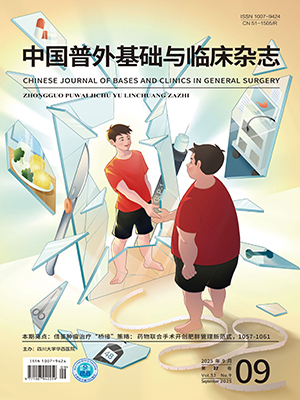| 1. |
Pories WJ, Swanson MS, Macdonald KG, et al. Who would have thought it? An operation proves to be the most effective therapy for adult-onset diabetes mellitus. Ann Surg, 1995, 222(3):339-350.
|
| 2. |
Rubino F. Is type 2 diabetes an operable intestinal disease? A provocative yet reasonable hypothesis. Diabetes Care, 2008, 31(12):290-296.
|
| 3. |
Sjostrom L, Lindroos AK, Peltonen M, et al. Lifestyle, diabetes, and cardiovascular risk factors 10 years after bariatric surgery. N Engl J Med, 2004, 351(26):2683-2693.
|
| 4. |
Alexandrides TK, Skroubis G, Kalfarentzos F. Resolution of diabetes mellitus and metabolic syndrome following Roux-en-Y gastric bypass and a variant of biliopancreatic diversion in patients with morbid obesity. Obes Surg, 2007, 17(2):176-184.
|
| 5. |
Meneghini LF. Impact of bariatric surgery on type 2 diabetes. Cell Biochem Biophys, 2007, 48(2-3):97-102.
|
| 6. |
Rubino F, Kaplan LM, Schauer PR, et al. The Diabetes Surgery Summit consensus conference:recommendations for the evaluation and use of gastrointestinal surgery to treat. Ann Surg, 2010, 251(3):399-405.
|
| 7. |
温雨晴, 谭迎春, 张蓬波, 等.胃转流术对2型糖尿病大鼠脂肪组织胰岛素抵抗的影响.中华实验外科杂志, 2013, 30(10):2324-2326.
|
| 8. |
张蓬波, 陈守坤, 张秀忠, 等.胃转流术对2型糖尿病大鼠肝组织胰岛素底物-2、葡萄糖转运体-2表达的影响.中华实验外科杂志, 2013, 30(12):2587-2589.
|
| 9. |
Goto Y, Kakizaki M. The spontaneous-diabetes rat:a model of noninsulin dependent diabetes mellius. Proc Jpn Acad B, 1981, 57(10):381-384.
|
| 10. |
Portha B. Programmed disorders of beta-cell development and function as one cause for type 2 diabetes? The GK rat paradigm. Diabetes Metab Res Rev, 2005, 21(6):495-504.
|
| 11. |
Simon A. Gastrointestinal surgery and gut hormones. Curr Opin Endocrinol Diabetes, 2005, 12(1):89-98.
|
| 12. |
Schauer PR, Kashyap SR, Wolski K, et al. Bariatric surgery versus intensive medical therapy in obese patients with diabetes. N Engl J Med, 2012, 366 (17):1567-1576.
|
| 13. |
王勇, 白洁, 匡立润, 等. Roux-en-Y胃旁路术对GK大鼠骨骼肌组织胰岛素抵抗影响的机制研究.中国普外基础与临床杂志, 2014, 21(2):162-167.
|
| 14. |
Shao J, Yamashita H, Qiao L, et al. Decreased Akt kinase activity and insulin resistance in C57BL/KsJ-Leprdb/db mice. J Endocrinol, 2000, 167(1):107-115.
|
| 15. |
Cusi K, Maezono K, Osman A, et al. Insulin resistance differentially affects the PI3-kinase-and MAP kinase-mediated signaling in human muscle. J Clin Invest, 2000, 105(3):311-320.
|
| 16. |
Biddinger SB, Kahn CR. From mice to men:insights into the insulin resistance syndromes. Annu Rev Physiol, 2006, 68:123-158.
|
| 17. |
Li SQ, Zhou Y, Wang Y, et al. Upregulation of IRS-1 expression in Goto-Kakizaki rats following Roux-en-Y gastric bypass surgery:resolution of type 2 diabetes? Tohoku J Exp Med, 2011, 225(3):179-186.
|
| 18. |
Wang X, Hu Z, Hu J, et al. Insulin resistance accelerates muscle protein degradation:Activation of the ubiquitin-proteasome pathway by defects in muscle cell signaling. Endocrinology, 2006, 147(9):4160-4168.
|
| 19. |
Goldberg AL. Nobel committee tags ubiquitin for distinction. Neuron, 2005, 45(3):339-344.
|
| 20. |
Goodyear LJ, Giorgino F, Sherman LA, et al. Insulin receptor phosphorylation, insulin receptor substrate-1 phosphorylation, and phosphatidylinositol 3-kinase activity are decreased in intact skeletal muscle strips from obese subjects. J Clin Invest, 1995, 95(5):2195-2204.
|
| 21. |
Caro JF, Ittoop O, Pories WJ, et al. Studies on the mechanism of insulin resistance in the liver from humans with noninsulin-dependent diabetes. Insulin action and binding in isolated hepatocytes, insulin receptor structure, and kinase activity. J Clin Invest, 1986, 78(1):249-258.
|
| 22. |
Xu X, Sarikas A, Dias-Santagata DC, et al. The CUL7 E3 ubiquitin ligase targets insulin receptor substrate 1 for ubiquitin-dependent degradation. Mol Cell, 2008, 30(4):403-414.
|
| 23. |
Rome S, Meugnier E, Vidal H. The ubiquitin-proteasome pathway is a new partner for the control of insulin signaling. Curr Opin Clin Nutr Metab Care, 2004, 7(3):249-254.
|
| 24. |
Balasubramanyam M, Sampathkumar R, Mohan V. Is insulin signaling molecules misguided in diabetes for ubiquitin-proteasome mediated degradation? Mol Cell Biochem, 2005, 275(1-2):117-125.
|
| 25. |
Song R, Peng W, Zhang Y, et al. Central role of E3 ubiquitin ligase MG53 in insulin resistance and metabolic disorders. Nature, 2013, 494(7437):375-379.
|




